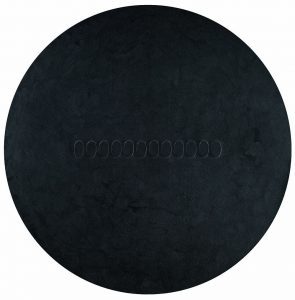
Turi Simeti in conversation with Federico Sardella, co-editor with Antonio Addamiano and the Turi Simeti Archive of the Catalogue raisonné, soon to be published by Skira, discusses his art, its form, colour and shape. The Milan-based artist’s monochromatic surfaces are charchterized by the elliptical form: it is in the oval that he seeks, and finds, the origins.

Federico Sardella: Since the early 1960s your work has focused on flat ovals “protruding” through the classic stretched canvas “from beneath”.
What made you think of this?
Turi Simeti: The choice of the oval was partly by chance, but was also the result of observation. Previously I had used flames to produce certain shapes. I scorched the edges to soften the borders of rectangles: I burned away a little here, a little there – and automatically ended up with an oval. I always liked this shape. Occasionally I also worked with round, rectangular or square forms, but I always kept coming back to the oval.
Is this to say that exploring other shapes has only further convinced you of the power of the oval?
The elliptical form reflects my nature. I always suspected that the oval would set the canvas in motion better than a circle would. This assumption proved to be true. The oval exerts a gentle pressure, and so seems almost asymmetrical. The circle appears harder, because it is completely round. The oval is soft. I felt – and still feel – a kind of fondness for the oval. In the area of the oval the surface gains an excitement, a vibrancy, the light gives it a depth. Light and shadow are very important in my work. Whenever I start work on a new piece, I know how it will later interact with the light. This white canvas, for example: if I move the lamp slightly the oval appears almost black; if the light comes from above, then it almost shimmers. There are so many possibilities and the light always acts independently of the colour of the work.
Do you have a p reference for certain colours?
For a while I limited myself to black-andwhite and grey pictures. Then I went over to red and yellow surfaces but in doing so always chose less vivid colours, using them in such a way that they did not seem garish. A colour should convey peace and tranquillity, even if it is red, yellow or – very rarely – green.
One of your works has always intrigued me: a bronze sculpture from 1997. It feels like a violation of the rules, an exception amongst your oeuvre, given its coherence. The sculpture seems to tell of a frame and of elements that make the canvas protrude like a relief …
This bronze sculpture with four ovals is a tribute to what is hidden in the picture. I have always been surprised by the question often put to me about what is concealed behind my pictures; time and again, people want to know how my works are made. A legitimate question, of course, and at some point – perhaps from weariness – I said to myself: now I will simply show them the reverse side. And that is how this sculpture came about. It is fully consistent with my other works, it just isn’t covered with a canvas that hides part of its structure. I decided to use bronze because the material gives the work “weight” – precisely because the sculpture shows how my works are made. People come with all kinds of assumptions. And now, whenever they pester me with questions, I simply show them a picture of the sculpture and there’s no need for any further explanation.

Did you also decide to produce the sculpture because you wanted to demonstrate that there is no trick involved, that there is a structure beneath?
Exactly, there is no trick to it. The work has a support, or rather: a structure that is obvious yet hidden. The structure is behind the scenes and props up the work. Thus the work has two sides, and an inner complexity that disperses in the moment of its creation.

Simeti
Catalogue Raisonné
edited by Antonio Addamiano and Federico Sardella
The catalogue raisonné of Turi Simeti represents an important publication devoted to the ar tist and his c areer. Conceived in direct collaboration with Simeti himself, supervised by Essila Burello, and published in two volumes, it offers an account of over 50 years of work by one of Italy ’s most eminent artists. It includes a series of important, previously unpublished images and documents.
Bilingual edition IT-EN / Skira Publishing
24 x 28 cm, 800 pages, 1,800 colour images
Hard-cover edition with slipcase
ISBN 978-88-572-3410-6
Contemporary Art auction
31 May 2017
Palais Dorotheum Vienna
Read more about Italian Artists
Photo Turi Simeti © Nicola Demolli Crivelli












